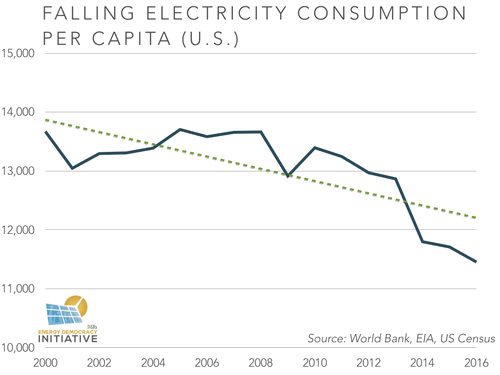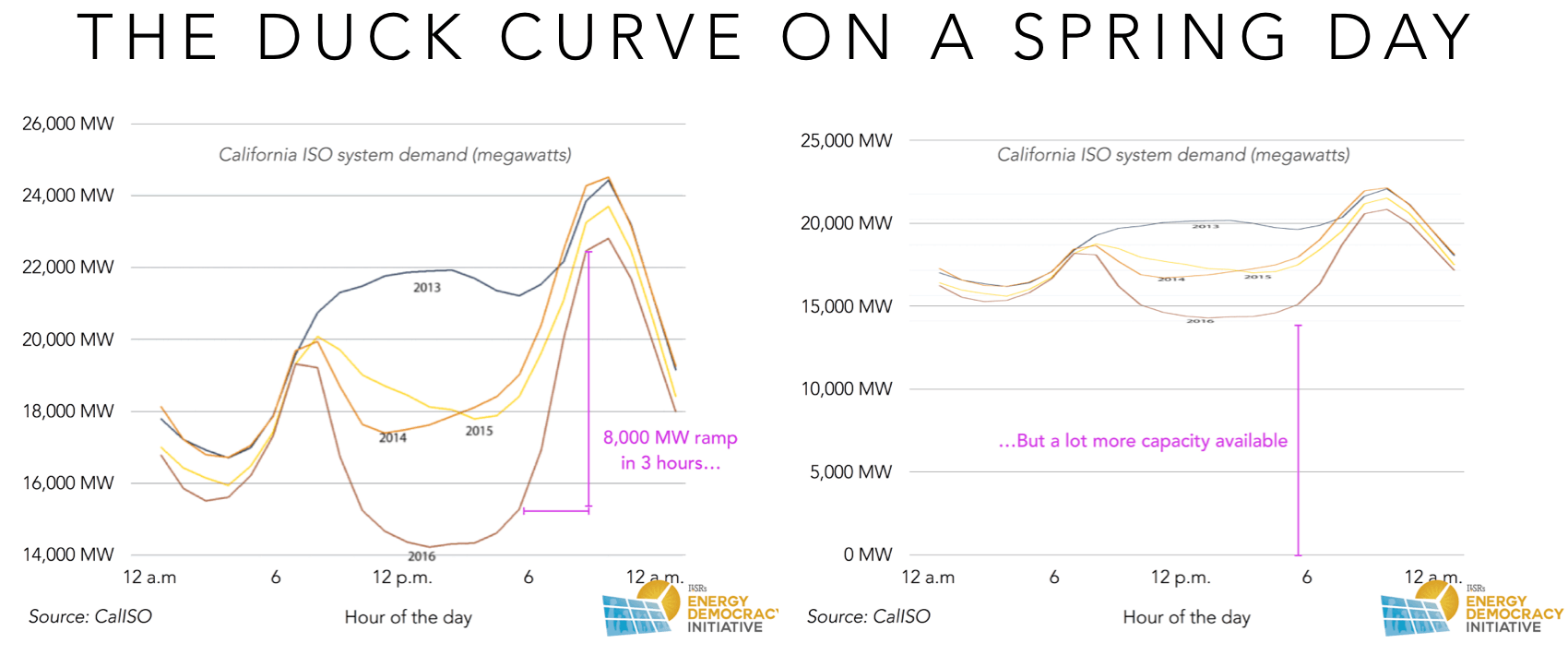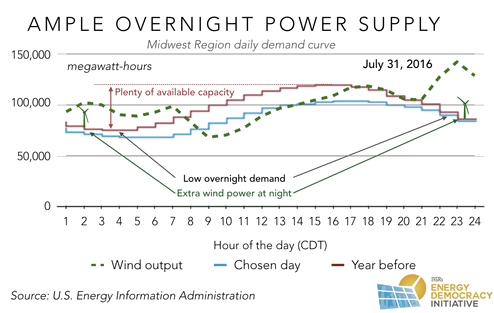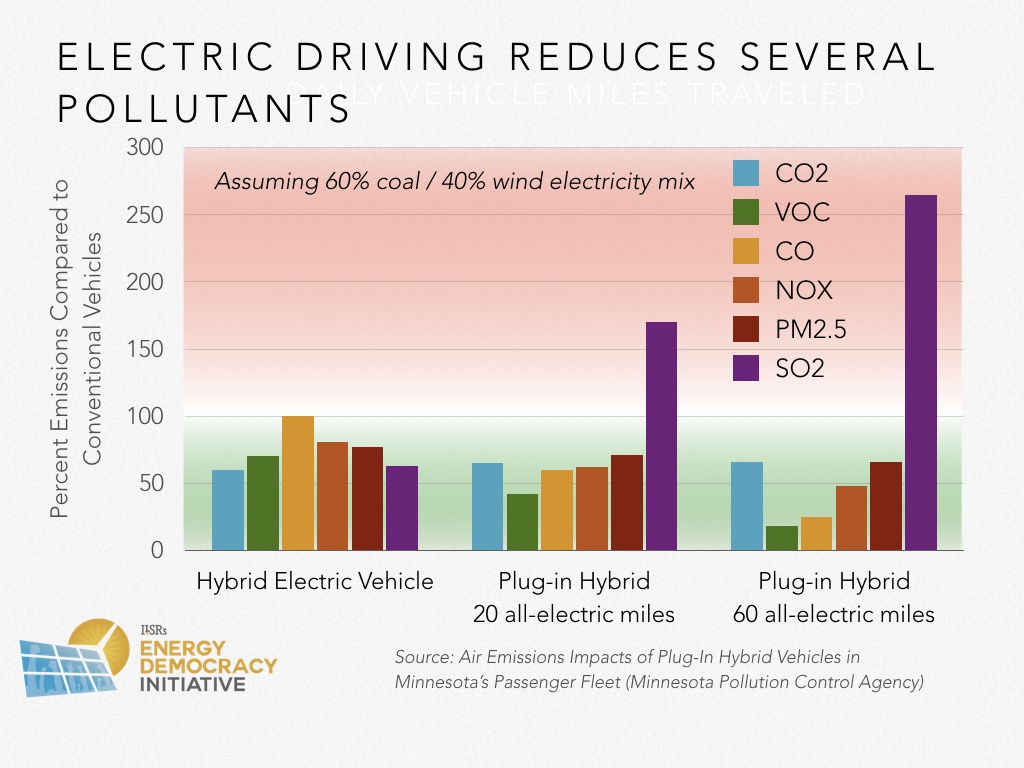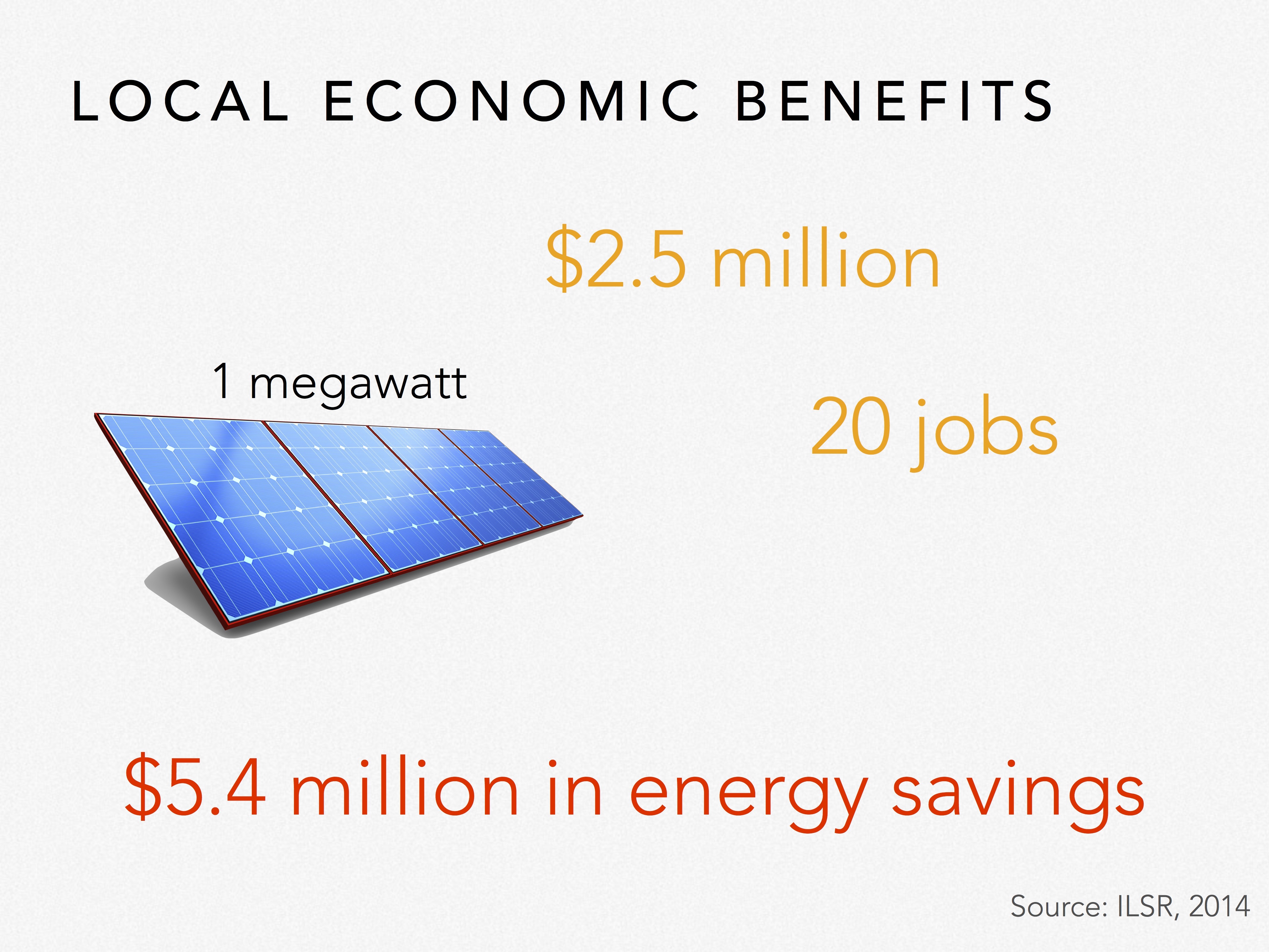Electric Vehicles Report: Part 2 — The Impacts Of The Electric Vehicle Revolution
The following is an excerpt of the Institute for Local Self-Reliance’s Choosing the Electric Avenue: Unlocking Savings, Emissions Reductions, and Community Benefits of Electric Vehicles report. We’ll be republishing the full report in order to bring more attention to the changing landscape of electric vehicles. Read part one.
Impact: Improving the Grid
Electric vehicles boost demand for electricity.
On one hand, that’s great news for utilities. The average electric-powered car driver covers 12,000 miles annually, and one study calculated that the additional 4,000 kilowatt-hours used by an electric vehicle would increase a typical household’s yearly energy need by 33% (without adoption of energy efficiency measures). In small numbers, electric cars will change little, but in large numbers they could reverse the stagnant growth in electricity use, which has dropped in five of the last eight years and affected the bottom line of many electric utilities.
On the other hand, could this increased demand also increase the cost of operating the electric grid (and costs for electric customers) by shortening the life of grid components, requiring replacement or upgraded infrastructure such as transformers and capacitors, or even building new fossil fuel power plants?
Fortunately, the evidence suggests that electric vehicle expansion will reward, not ruin, the grid and its customers.
A rigorous analysis spearheaded by the California Public Utilities Commission in 2016 found substantial net benefits in electric vehicle adoption for the state’s electric grid and customers: worth $3.1 billion by 2030, even without smart charging policies and with vehicle adoption clustering in particular areas of the grid. This included the benefits of capturing federal tax credits, gasoline savings, and carbon credits in California’s greenhouse gas allowance transportation market plus all of the associated costs to the customer and grid.
The study also found surprisingly low costs for upgrading the local distribution grid. Even with a much higher vehicle adoption assumption of 7 million cars by 2030 (one-quarter of all registered vehicles), annual distribution infrastructure costs would be just 1% of the annual utility distribution budget.
A rigorous analysis by the California Public Utilities Commission found substantial net benefits in electric vehicle adoption: $3.1 billion by 2030, even without smart charging policies and with vehicle adoption clustering in particular areas of the grid.
A set of studies for northeastern states found a similar net benefit, even without smart charging policies, for vehicle owners, utilities, and society.
Relatively simple policy changes can enhance the payoff of adding thousands or millions of electric vehicles to the grid. California’s study suggests that the most potent and simplest tool to smoothly integrate electric vehicles is controlling when they charge. This can be done with special rates that give customers a discount for charging at grid-friendly times, or even using special chargers that disallow charging when grid demand is at its highest. These tools increase the efficiency of the electricity system, but also mean lower-cost fuel for electric vehicle owners, a win-win.
Relatively simple policy changes can enhance the payoff of adding thousands or millions of electric vehicles to the grid. California’s study suggests that the most potent and simplest tool to smoothly integrate electric vehicles is controlling when they charge.
In an exhaustive analysis using time-of-use (TOU) pricing to strongly incentivize nighttime charging, the California Public Utilities Commission found that shifting from flat-rate to time-of-use charging increased net benefits from $3,600 to $5,000 per vehicle through significant reductions in the energy and infrastructure costs of charging.
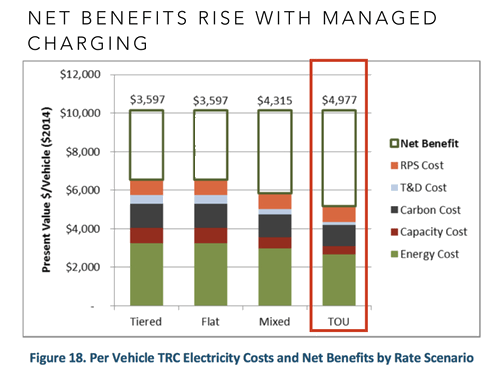
While the California calculation includes the federal tax credit, the benefits are expected to persist even when that incentive expires because of falling electric vehicle and battery costs.
This following sections explore pricing tools that allow utilities and regulators to better manage grid supply and demand, rather than building new power infrastructure that could be obsolete early in its decades-long life.
EV Charging Terminology
A quick note on charging before we dive in. Electric vehicles can be charged at different speeds by using different voltages. A standard 120-volt outlet can deliver about 1.3 kilowatts per hour but may take 12 or more hours to fully charge a vehicle. A 240-volt circuit can deliver a substantially faster charge and can be wired in a typical home or business. Direct current (DC) fast charging uses 440-volt charging that can “refuel” an electric vehicle battery in less than an hour. The following graphic from FleetCarma illustrates.
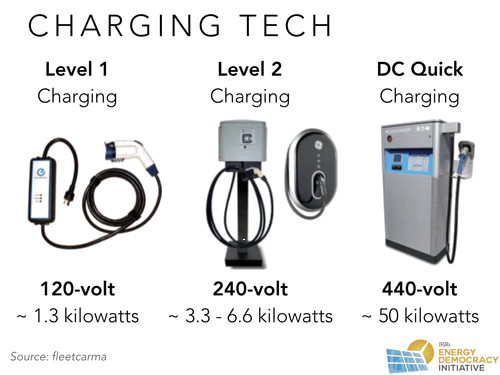
Managing Demand
With proper price incentives, grid managers can motivate electric vehicle users to avoid charging during periods of peak demand, to instead charge when demand is otherwise low, and to help smooth out large increases or decreases in demand.
The electric grid is designed around periods of peak energy use, with requirements for significant energy reserves dictated by the single-most congested hour of the year. By raising electricity prices at times of peak energy use (and reducing them elsewhere), utilities can largely minimize electric cars’ contribution to peak energy demand. Recent modeling by the Rocky Mountain Institute suggests optimized charging rates would limit Minnesota’s peak demand increase, for example, to just 0.5% when electric vehicles hit 23% penetration, compared with an increase of more than 3% without charging controls.
Minnesota wasn’t alone. In the four other states modeled, the Rocky Mountain Institute found peak demand impacts of widespread electric vehicle adoption could be significantly reduced with controlled charging. The following graphic illustrates.
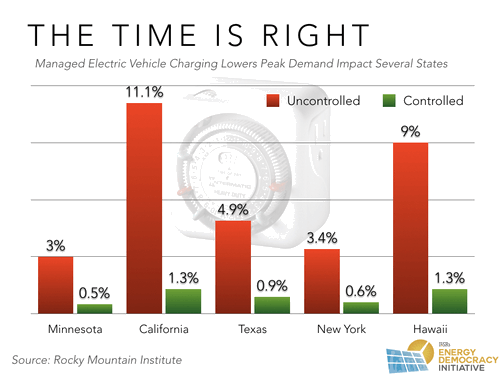
Utilities can also leverage electric vehicles to manage rapid changes in electricity demand. Historically, these ramps up or down have been driven by a morning surge in demand as people wake up and turn on lights and appliances, and another in the evening when stores remain open and residents return home. In some cases, these ramps are also influenced by rooftop solar generation, which sharply reduces demand from solar-powered neighborhoods in the daytime but spurs a sharp increase in local demand in the evening when residential demand increases as the sun sets.
Utilities typically prepare for these surges by activating gas power plants that can be put on standby or ramped up quickly. However, because these plants are relatively under-utilized, the electricity provided at peak periods is expensive. An August heat wave in Texas, for example, sent hourly electricity prices on the grid well over $1 per kilowatt hour on several occasions, more than ten times the usual price.
Utility wonks illustrate this challenge with the “duck curve,” shown below for the California Independent System Operator (CAISO). The issue is the steep curve starting around 4 p.m. and peaking around 8 p.m., driven largely by adoption of rooftop solar that drives down daytime electricity demand. One caveat: the deep dip is sometimes called “overgeneration” — implying that there’s too much solar energy production — an issue enhanced when the bottom axis reflects a minimum of 14,000 megawatts. One German observer notes that this issue (as opposed to the ramp) is exaggerated. For context, the chart is also shown with a zero axis.
Although there are many potential solutions (the linked report from the Regulatory Assistance Project is particularly thorough), electric vehicles can help smooth the curve. By drawing power from the grid during the midday hours when solar output is greatest, electric vehicles can soak up the sun-generated power and in turn reduce the evening ramp-up. Fortunately, data from California suggests that 40% of electric vehicles remain at home even through the midday hours. If vehicle owners have access to charging at home and at work, over 70% of vehicles are available to absorb excess daytime electricity generation.

By charging these idle electric vehicles during daytime hours, grid operators could reduce the steep afternoon ramp-up in electricity demand. The chart below illustrates how charging these vehicles between 11 a.m. and 4 p.m. would help smooth the rise in demand, giving grid managers more time to accommodate increasing electricity consumption.
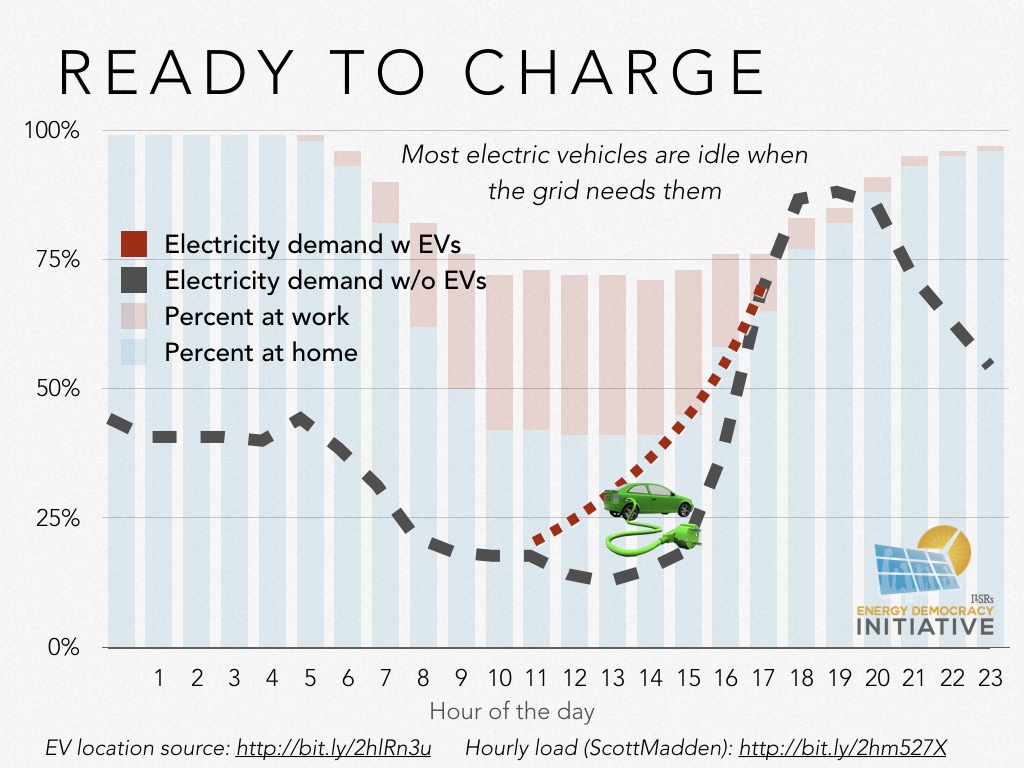
The amount of additional demand needed from electric vehicles to achieve this outcome is well within projected capacity. The 1.5 million electric cars California expects by 2025 would have a maximum energy demand of about 7,000 megawatts, more than double the capacity needed to substantially smooth the current afternoon rise in peak energy demand.
As discussed later, widely distributed charging infrastructure will be key to accessing this resource, as few homes or businesses currently have car chargers. Furthermore, the amount and availability of bill credits or compensation for grid exports (or in the case of Hawaii, a tariff that provides no payment for excess solar production) will strongly impact customer behavior.
Soaking Up Supply
Charging controls or pricing incentives can also motivate electric vehicle drivers to charge overnight, or whenever clean energy production is strongest.
In markets like the Midwest that have abundant wind power, clean energy production often peaks overnight when demand is lowest. The chart below shows the daily demand curve for the Midwest Independent System Operator, which serves a number of states in the Midwest. The 50,000 megawatt-hour gap between daytime and nighttime demand (in July, when the grid is built to accommodate daytime load boosted by air conditioning) could accommodate over 7.5 million electric vehicles on Level 2 (240-volt) chargers without building a single new power plant. That’s almost 2 million more cars than the total number registered in the entire state of Illinois.
The 50,000 megawatt-hour gap between daytime and nighttime demand could accommodate over 7.5 million electric vehicles on Level 2 (240-volt) chargers without building a single new power plant.
The hungry batteries of electric vehicles can also be coordinated to improve the capture of wind and solar power.
The most common constraint in a grid with high levels of renewable energy (over 30%) is overgeneration. This happens when there’s so much renewable energy available that making room for it would mean ramping down or turning off inflexible power plants (coal, nuclear, hydro). In electricity markets, renewables tend to undercut any other resource because — having no fuel — they have almost no marginal cost to produce electricity.
Electric vehicles represent a new source of electricity demand that can absorb this excess production.
Charging electric cars during nighttime low-demand periods, for example, means increasing the use of wind energy. A 2006 study from the National Renewable Energy Lab found that electric vehicle deployment “results in vastly increased use of wind” because overnight vehicle charging overlaps with windier nighttime conditions. A 2011 study from the Pacific Northwest National Laboratories found that if one in eight cars were electric, the additional storage capacity would allow the Northwest grid to handle 12% more wind energy.
Electric vehicles can also help grids put more solar power to use. The illustration in the previous section — Ready to Charge — illustrates how most electric cars could be available to charge during afternoon hours to absorb solar energy output, although it requires daytime charging (and potentially non-home charging infrastructure) that nighttime charging does not.
Portuguese researchers found that growth in both solar generation and electric vehicles maximizes the grid benefits of each. Portugal’s heavy emphasis on solar generation means that, as time goes on, it will build up a “substantial amount” of excess daytime solar energy. Because neighboring countries are also building out their solar portfolios, Portugal’s exports would yield low prices, suggesting that solar power might be curtailed (or lost) instead. But researchers found that an expanded electric vehicle fleet — and a preference for midday workplace charging — could decrease the midday solar surplus by 50%.
A separate Portuguese study includes analysis of simulated solar production during a given week in April. With no electric vehicles, 202 gigawatt-hours — or 48% of solar production — was curtailed during that span. With electric vehicles added to the mix, curtailment fell to 123 gigawatt-hours, or 29% of solar production.
Together, solar and electric vehicles can do more to smooth the demand curve than either technology could on its own. The following chart, from the Rocky Mountain Institute, shows how optimized electric vehicle charging increases daytime electricity demand by over 200 megawatts (nearly 14% of peak demand) in Hawaii, allowing for more solar production.
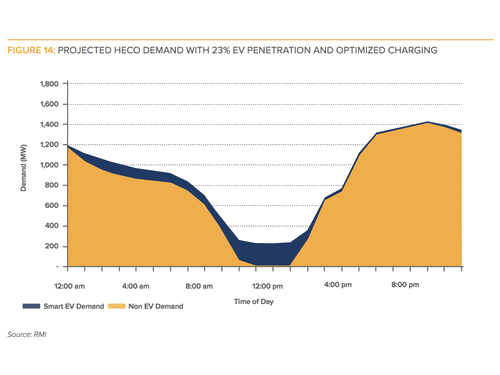
Other studies confirm this potential. A 2012 study by the Imperial College of London, for example, suggests that energy storage, including electric vehicles, can reduce curtailment of renewables by more than half.
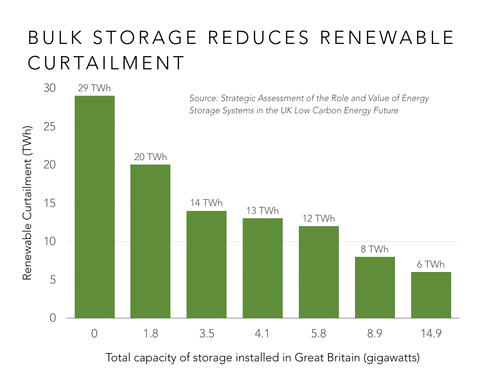
Providing Ancillary Services to the Grid
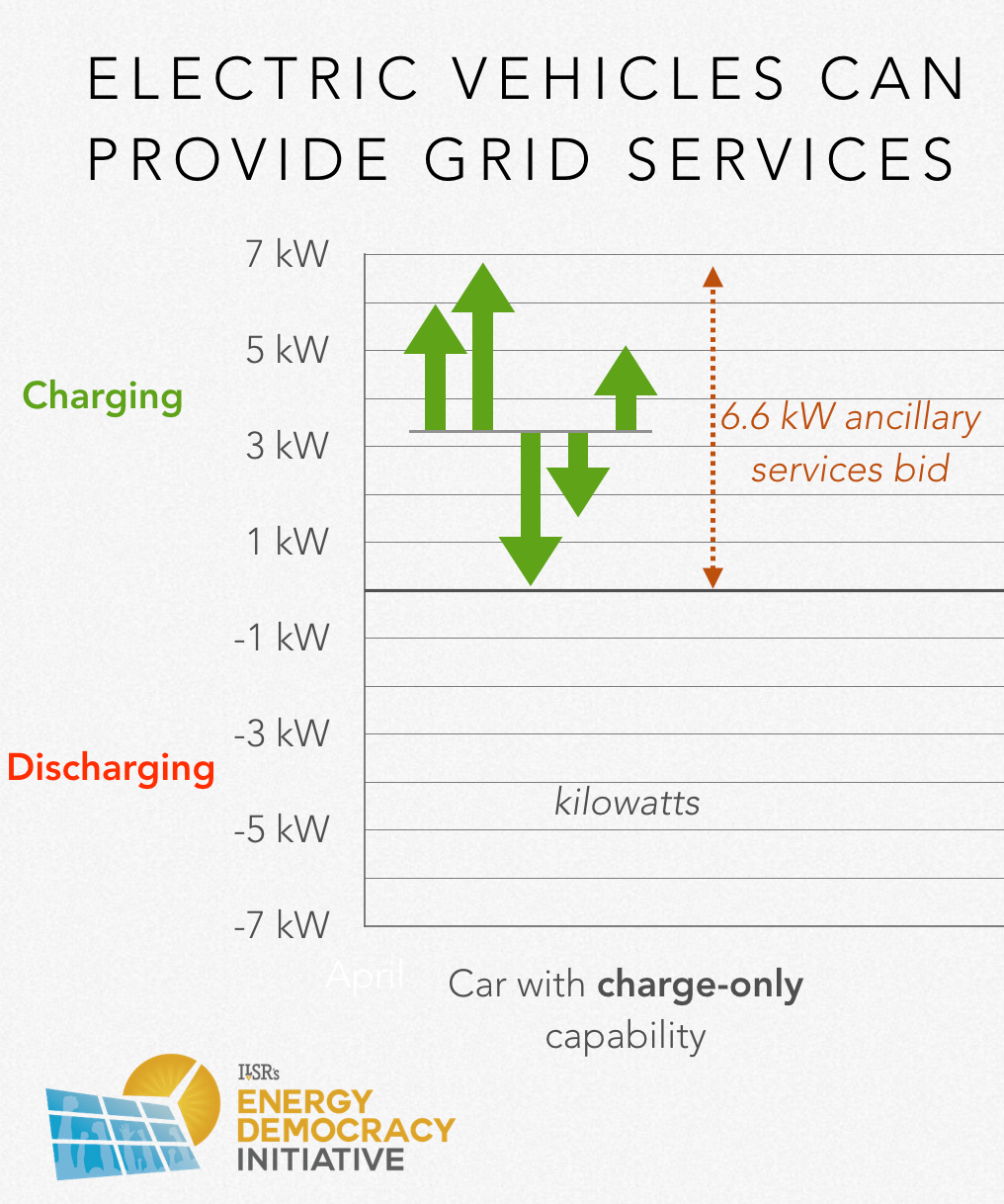
By starting, stopping, or varying the level of charge, electric vehicle batteries can provide two crucial “ancillary” services to the grid: helping maintain a consistent voltage (120 volts) and frequency (60 Hertz). These services are provided by short bursts of “reactive” power: either drawing power from the grid or putting it back in. Since nearly all commercially available electric vehicles lack the ability to send power to the grid, car batteries would provide reactive power today only by drawing power (charging).
The vehicle’s ability to aid the grid also hinges on the power of its charger and the ability to aggregate with other vehicles. On a typical home 120-volt outlet allowing up to 1.3 kilowatts of power per vehicle, it would take over 250 vehicles to reach the minimum threshold to provide ancillary services in energy markets run by regional grid operators PJM or MISO, which cover a substantial portion of the U.S. A 240-volt Level 2 charger with a capacity as high as 6.6 kilowatts per car significantly reduces the number of vehicles needed (as few as 27) to join the market.
Electric vehicles can provide substantial value to the grid as they charge (and in the future, perhaps by supplying power back to the grid, see Appendix A — The Vehicle-to-Grid Future).
Impact: Cutting Pollution
One major benefit of electric vehicles is reducing pollution impacts of driving. The following chart shows the greenhouse gas emissions from electric vehicles based on the grid electricity supply in 2015. The numbers on the chart are the miles per gallon required from a gasoline-fueled vehicle to have the same greenhouse gas emissions impact as an electric vehicle. The numbers will have risen since 2015, as additional coal plants have been retired.
Driving electric also significantly reduces other pollutants. The adjacent chart is from a 2007 study of the pollutant impact of hybrid and plug-in hybrid cars in Minnesota. It assumes a grid with a mix of 40% wind power and 60% coal power. The former is likely in the next decade, the latter is laughable in the face of a massive switch from coal to gas and renewables. With that context in mind, the bar representing sulfur dioxide should be ignored as the emissions rate of sulfur dioxides is 99% lower with natural gas, and 100% lower with more wind or solar power.
Impact: Readying Energy Democracy
The cumulative power of electric vehicles goes beyond stabilizing the larger electricity system; it offers an opportunity to draw more power from the local economy. Electric vehicles operate in a distinct geography (near the owner) and therefore their benefits are localized. This makes electric vehicles part of a larger transition from energy monopoly to energy democracy, as distributed technology from solar to smartphones localizes everything — production, consumption, and decision making — on the electric grid.
The following graphic illustrates the shift from energy monopoly to energy democracy. The flow of electricity changes from one-way to two-way as many customers install rooftop solar and purchase electric vehicles. The share of renewable energy grows and that of fossil fuel power shrinks. In general, the community sources more of its energy locally.
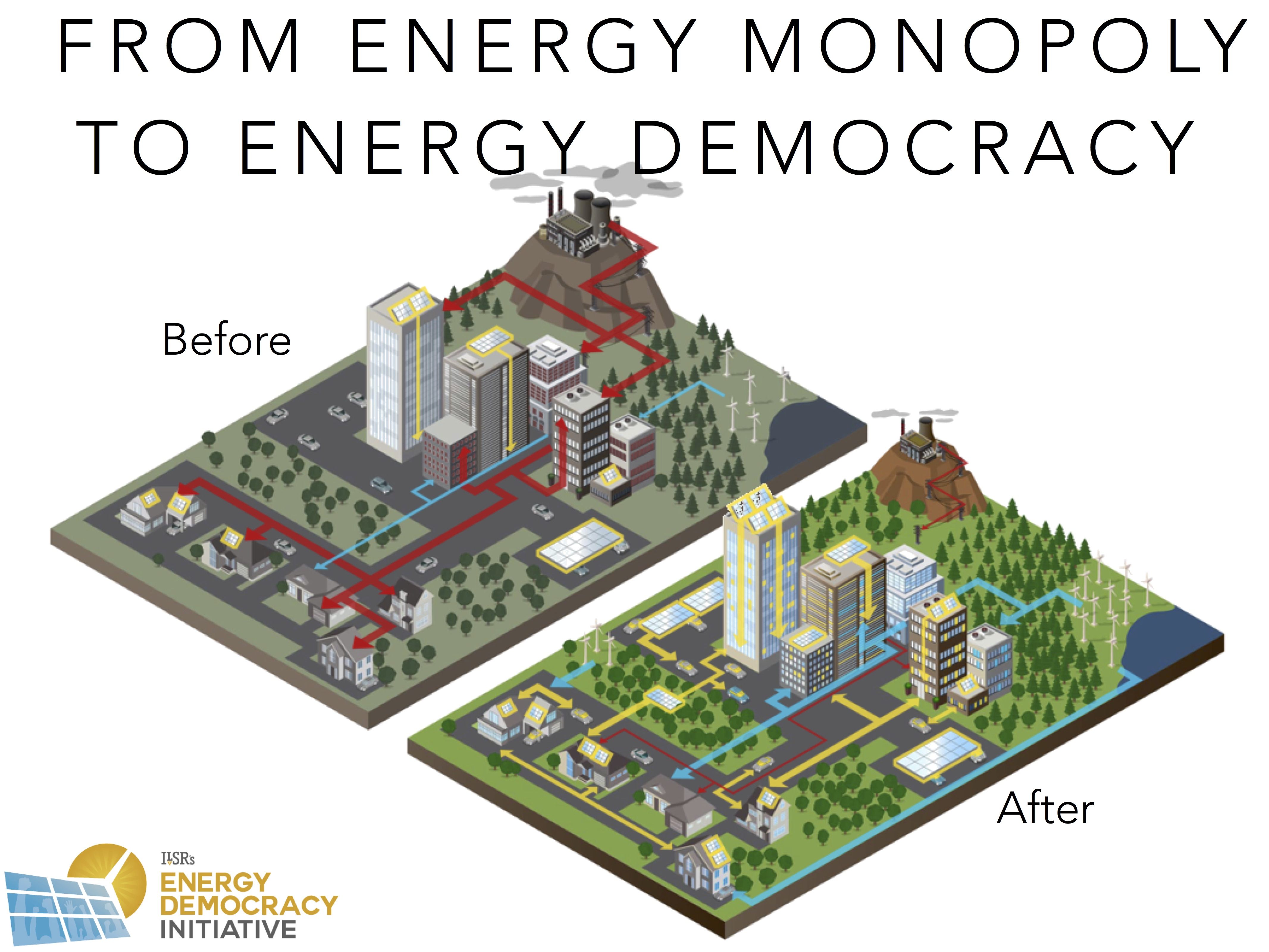
This section details the three key local benefits of electric vehicles: enabling the combination of the “sexy electrics” (solar and electric cars); increasing the capacity for local distributed solar energy production; and providing resilient, local backup power.
Complementary, Sexy Technology
Electric vehicles can encourage increased deployment of distributed solar. The same environmental values and spending habits that helped rocket the Toyota Prius to 1 million sales in a decade propel people to install solar panels. Like the conspicuous sustainability credential provided by the unique Prius, economists have speculated that homeowners invest more in solar panels than more affordable insulation and caulking. As such, it is not surprising that two of the clearest signals of green values — electric vehicle ownership and rooftop solar installation — often go hand-in-hand.
In California, roughly 39% of electric vehicle drivers also owned residential solar in 2013 — far outpacing the general population in the US, where less than 1% of all households had rooftop arrays through the second quarter of 2016. Meanwhile, 17% of California electric vehicle drivers expressed “strong interest” in installing solar in the near future. Of those that already had both, 53% said they sized their at-home solar systems with electric vehicle charging in mind, exposing synergies that reduce grid strain and help accommodate higher electricity demand.
Boulder County, CO, captured this complementary relationship by offering a program that promoted bulk buying for electric vehicles and solar. Area residents could opt in to access discounts on their purchase of either upgrade. The initiative provided a significant boost to electric vehicle sales. During the September-to-December promotional period, a local dealership sold 85 Nissan Leafs in 2013 and 2014 before jumping to 173 in the same period in 2015. Boulder County, home to less than one-tenth of 1% of the US population, accounted for 3.5% of all US Leaf sales over that span.
Meanwhile, program participants installed 147 solar arrays totaling 832 kilowatts. At least 19 households (over 10% percent of those participating) purchased both a Leaf and a solar array, and of that group, 11 right-sized their solar project to ensure it could power both their home and their new electric vehicle. By harnessing the federal electric vehicle tax credit alone, participants brought $1.8 million into the local economy — a huge gain, considering Boulder County estimated the program required just 165 hours of staff time and $650 in out-of-pocket expenses. The program was aided by the state electric vehicle tax credit, worth about $3,800 per car or $660,000 altogether.
The relationship between solar and electric vehicles may not remain as tight in the long term. A 2016 survey of plug-in car owners found that the percentage owning a solar array had fallen from 25% in 2012 and prior to 12% in 2015. This could be due to less affluent car owners or vehicle sales in areas with poorer solar resources. On the other hand, it also means that electric vehicles are dispersing beyond the very savvy customers that already own solar.
Either way, electric vehicles and solar arrays are both appealing to consumers, in a way that other energy improvements are not. And fortunately, this marriage of sexy electrics delivers benefits to the grid and local economy.
Electric Vehicles and Community Solar?
As electric vehicle ownership expands, it will reach many Americans who lack a sunny rooftop but may still have interest in solar. Community solar programs allow these customers to invest in or subscribe to solar energy projects, and the revenue from these subscriptions could offset the cost of charging an electric vehicle. It also allows them to, indirectly, charge their car from the sun.
The technical benefits of marrying solar and electric vehicles using community solar would be diminished unless customers subscribed to a community solar array located on the same distribution feeder as their primary place of vehicle charging.
Increasing Local Energy Capacity
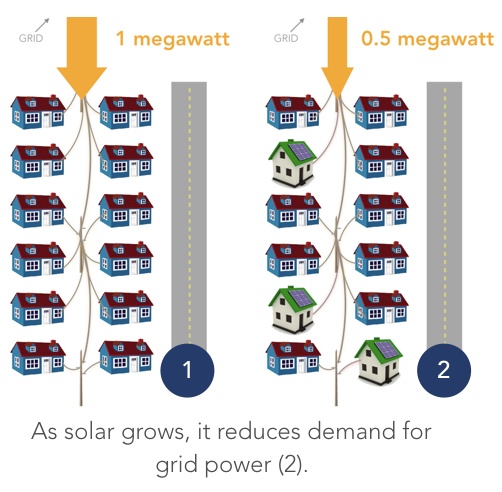 Electric vehicles boost electricity demand and expand local storage, increasing capacity to produce more electricity from local, renewable sources.
Electric vehicles boost electricity demand and expand local storage, increasing capacity to produce more electricity from local, renewable sources.
Solar energy, for example, can reduce a neighborhood’s peak energy consumption. If a community is served by a distribution line with a maximum capacity of 1 megawatt and it’s running near that limit, the utility may consider an expensive hardware upgrade. But adding local solar can reduce demand during hot, sunny summer afternoons, potentially allowing the utility to defer that upgrade.
We illustrate the effect in the graphic to the right. If many homes and businesses in a neighborhood add rooftop solar, it supplants power from the grid with local energy to avoid new capacity needs.
As solar continues to proliferate, a second set of issues can arise. Lots of small solar power plants can result in a portion of the local grid remaining energized when there’s a larger blackout. This could cause safety issues for utility workers who would expect power lines they’re repairing to be dead. However, smart inverters for solar arrays can automatically turn off power production when the grid goes dark. An even better solution is to island the home or business with solar, allowing them to have power even when the grid is dark. Newer inverters can supply up to 1500 watts for use during blackouts, even as the solar array stops sending power to the grid.
A second issue is a technical and competitive concern called “backfeed.” Backfeed is what happens when the supply of electricity (including from local solar) exceeds total use on a certain area of the grid. In this case, power flows back onto the grid, as shown in the illustration below.
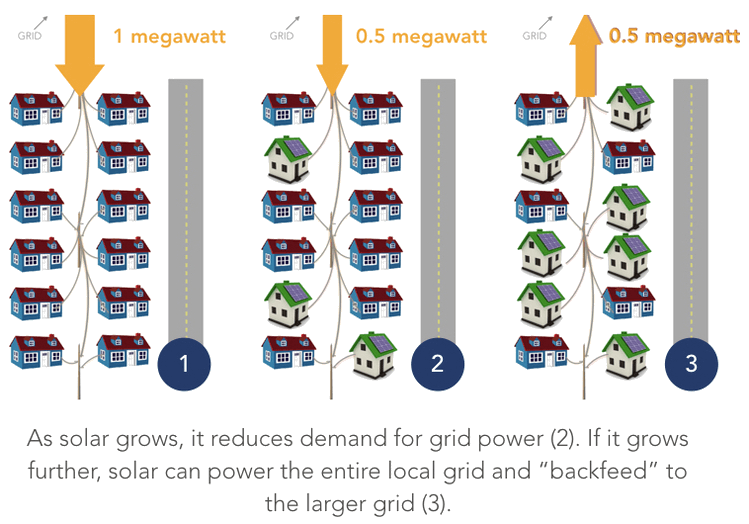
This may require substation upgrades to mediate power flow from the high-voltage regional grid to the low-voltage local grid, which weren’t designed with this flow in mind. It also allows local solar generation to compete against many other sources of electricity, including traditional fossil fuel power plants. In the many states where the utility company is responsible for grid safety and owns power plants that would be in competition with local solar, this creates a challenging conflict of interest.
Electric vehicles can solve backfeed issues by absorbing more local power generation, in turn enabling it to serve local needs. This also reduces wear and tear on utility hardware, inevitable in longer-distance power distribution. The following illustration shows how increasing electric vehicle ownership can reduce solar energy exports to the larger grid.

Without an additional local source of energy consumption, utilities can “curtail,” or effectively shut off, clean power production from local solar arrays. But a 2016 study in Hawaii confirmed that more electric vehicles on the grid translates to greater potential reductions in curtailed energy. That is especially significant in a rooftop solar stronghold — 17% of utility customers in Hawaii generate their power this way, including at least 32% of single-family homes on Oahu. The study’s authors modeled a scenario where 10% to 30% of Oahu vehicles were electric, and predicted an 18% to 46% reduction in curtailed generation when vehicle charging was controlled to match local power production. In this model, wind and solar provided close to 50% of the island’s total electricity needs.
The authors cautioned that marked day-to-day fluctuations in wind and solar curtailment obscure the precise effects of controlled charging in capturing curtailed energy, but found that using electric vehicles to integrate more storage makes distributed generation more valuable, more effective, and even more pervasive.
It’s a scenario that could play out in markets across the country. For example, the California grid operator CAISO reported 132 megawatt-hours in local curtailments of solar generation between 10 a.m. and 2 p.m. on Sept. 15, 2016. These curtailments were due to a limit on the capacity of the local grid to export. Typically, such curtailments involve utility-scale solar. If the capacity of the average electric car battery is 30 kilowatt-hours (the size of that in the 2017 Nissan Leaf), 8,800 parked electric vehicles needing a 50% charge could collectively offset that day’s curtailment, benefiting those generating solar power and helping to stabilize the grid.
Local Value
Sourcing power locally has two spillover benefits. First, it keeps more of the economic benefits of power generation within a given community. A typical 1-megawatt solar array creates $2.5 million in local economic activity and 20 jobs. Through its 25-year lifetime, a locally owned solar project will redirect an additional $5.4 million of electricity spending back into local hands.
The energy may also be more valuable to the grid if it is consumed locally, as ILSR explains in our 2016 report, Is Bigger Best? In many debates nationwide over the proper valuation of solar, most policy outcomes include a higher value for energy that can be used on-site or locally, rather than exported to the larger grid. Utilities and regulators in Hawaii and New York, for example, have adopted measures for distributed solar that favor on-site consumption.
Resiliency
Electric vehicles can also provide individuals and communities greater resiliency in the face of natural disaster. In the wake of week-long power outages following Hurricane Sandy, many communities on the East Coast sought ways to reduce their reliance on their (often distantly located) utilities. Many states encourage the installation of solar energy generation and even microgrids, miniature versions of the electric grid that can operate when the larger grid goes dark. Microgrids, typically powered by solar and batteries, could use electric vehicles to soak up excess energy production — and keep it local — to provide power during extended grid outages.
A pilot project at the University of California-San Diego, a campus which supplies more than 90% of its own energy, equipped its microgrid to host 70 electric vehicle chargers. The microgrid can ramp down charging to reduce campus-wide demand. In turn, drivers who allow flexibility in charging receive compensation when their vehicles perform services like frequency regulation. This symbiosis makes electric vehicle integration a compelling prospect for microgrid operators and vehicle owners.
“The link between a microgrid and an electric vehicle can create a win-win situation wherein the microgrid can reduce utility costs by load shifting while the electric vehicle owner receives revenue that partially offsets his/her expensive mobile storage investment,” researchers wrote in a 2010 study from the Lawrence Berkeley National Laboratory.
While microgrids currently comprise a small portion of the total US electric generation capacity, their numbers are expected to double or triple within a decade — rising in tandem with electric vehicle ownership in the US. Particularly as both markets grow, outfitting microgrids with technology to tap into storage and ancillary services from electric vehicles can fortify local power systems. Together, electric vehicles and microgrids promote resiliency.
As noted above, electric vehicles may also offer a resiliency benefit to existing “microgrids” — homes. The typical second-generation electric vehicle battery (such as the Chevrolet Bolt) stores sufficient electricity to power the average American home for two days. This is a powerful secondary benefit for a purchase centered on mobility.
The typical 2nd generation electric vehicle battery (such as in the Chevrolet Bolt) stores sufficient electricity to power the average American home for two days.
Read the full report online, here. For timely updates, follow John Farrell or Karlee Weinmann on Twitter or get the Energy Democracy weekly update.
Photo Credit: Micadew via Flickr (CC 2.0) & Nissan.
Have a tip for CleanTechnica? Want to advertise? Want to suggest a guest for our CleanTech Talk podcast? Contact us here.
Latest CleanTechnica.TV Video

CleanTechnica uses affiliate links. See our policy here.


